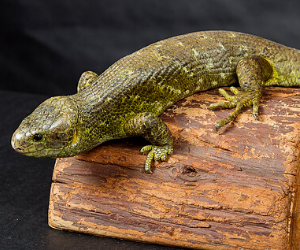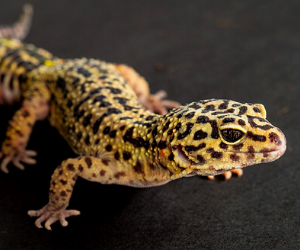August 14th is World Lizard Day. Why do we need a day to celebrate a group of reptiles? Lizards are an incredibly unique and diverse family. The tiny leaf chameleon from Madagascar is less than 1-inch long from the tip of its snout to the base of its tail, whereas the Komodo dragon can reach lengths of nearly 10 feet! Lizards are adapted to live in the most arid of deserts, to lush and humid rainforests. Some can change color, some are venomous, and some can regenerate voluntarily dropped tails. Ecologically, lizards are important as both predator and prey species, and are beneficial in helping to control agricultural pests such as rodents and insects. While a few species of lizards can be seen during a visit to Akron Zoo, several more lizards reside as education, or ambassador, animals at the zoo. Let’s meet Louis and Styx!
Prehensile-tailed Skink, “Louis”
 The prehensile-tailed skink is native to the rainforests of the Solomon Islands in the Pacific Ocean, off the east coast of Papua New Guinea. This lizard is also sometimes called the monkey-tailed skink, since it can use its prehensile tail to grasp branches while climbing in trees, similar to a monkey. These elusive herbivores nap in the trees during the day, and feed on leaves and fruit throughout the night. While most baby reptiles hatch from eggs outside of the mother’s body, the prehensile-tailed skink is different. The female is ovoviviparous, which means the baby skink hatches from its egg while still inside of its mother, so the birth looks similar to a mammalian birth. A female prehensile-tailed skink will typically only have 1 baby at a time, which is a very slow reproductive rate for a reptile. To add to their uniqueness, the baby skink not only stays with its mother, but also its father, for about 6 months. Both parents will defend the baby and help it to learn its way in the rainforest. Unfortunately, prehensile-tailed skinks face danger from deforestation and the pet trade, and are a threatened species. Many accredited AZA institutions participate in the Prehensile-tailed Skink Species Survival Plan (SSP) in order to help maintain a sustainable population of these amazing lizards in zoos.
The prehensile-tailed skink is native to the rainforests of the Solomon Islands in the Pacific Ocean, off the east coast of Papua New Guinea. This lizard is also sometimes called the monkey-tailed skink, since it can use its prehensile tail to grasp branches while climbing in trees, similar to a monkey. These elusive herbivores nap in the trees during the day, and feed on leaves and fruit throughout the night. While most baby reptiles hatch from eggs outside of the mother’s body, the prehensile-tailed skink is different. The female is ovoviviparous, which means the baby skink hatches from its egg while still inside of its mother, so the birth looks similar to a mammalian birth. A female prehensile-tailed skink will typically only have 1 baby at a time, which is a very slow reproductive rate for a reptile. To add to their uniqueness, the baby skink not only stays with its mother, but also its father, for about 6 months. Both parents will defend the baby and help it to learn its way in the rainforest. Unfortunately, prehensile-tailed skinks face danger from deforestation and the pet trade, and are a threatened species. Many accredited AZA institutions participate in the Prehensile-tailed Skink Species Survival Plan (SSP) in order to help maintain a sustainable population of these amazing lizards in zoos.
Akron Zoo’s prehensile-tailed skink is named Louis, because he was born at the St. Louis Zoo in 2004. He joined the Akron Zoo ambassador animal family in 2009. While staff all referred to Louis as a male (likely because of his name), we didn’t know for sure that he was a male until earlier this year when the SSP requested we do a blood test to confirm his gender for potential breeding purposes and…it’s a boy! Louis is a very laid-back lizard. Most often, he is lounging on a branch in his house while keepers take care of him, but sometimes he is more engaging and shows interest in what the keepers are doing by repeatedly flicking his tongue to smell what’s new. For any parent that has trimmed the toenails on a wiggly toddler, just imagine picking tiny pieces of shed skin off the toes of a wiggly lizard – not one of Louis’s favorite activities, but his caretakers do it with love and for the health of his toes during a shed. Louis loves red grapes, and also currently loves a cardboard box hide house made for him that he’s been sleeping in for over a week.
Uromastyx, “Styx”
 Uromastyx lizards are found in desert habitats throughout various regions in northern Africa and the Middle East. These lizards love the sun! They can be seen basking on rocks in the morning, soaking up the beneficial UVB rays, and then retreating to underground burrows during the hottest parts of the day. Being a desert animal, it is very important for them to conserve water in their bodies. Any excess salt in their bodies is secreted out in the form of a whitish-crusty material from special glands near their nostrils, giving the uromastyx the appearance of often needing a tissue! Uromastyx lizards are primarily herbivorous, feeding on the tough vegetation growing in their arid environment, but will occasionally eat insects as well. In addition to having excellent camouflage, these lizards also have a very powerful tail lined with spikes that they will use as a defense – a hungry predator will think twice about proceeding after being struck in the nose by those sharp spines. Though the conservation status of the uromastyx has not been thoroughly evaluated, trade in these animals is regulated due to acknowledgement that their habitat faces threats from over-grazing by livestock and also the pet trade.
Uromastyx lizards are found in desert habitats throughout various regions in northern Africa and the Middle East. These lizards love the sun! They can be seen basking on rocks in the morning, soaking up the beneficial UVB rays, and then retreating to underground burrows during the hottest parts of the day. Being a desert animal, it is very important for them to conserve water in their bodies. Any excess salt in their bodies is secreted out in the form of a whitish-crusty material from special glands near their nostrils, giving the uromastyx the appearance of often needing a tissue! Uromastyx lizards are primarily herbivorous, feeding on the tough vegetation growing in their arid environment, but will occasionally eat insects as well. In addition to having excellent camouflage, these lizards also have a very powerful tail lined with spikes that they will use as a defense – a hungry predator will think twice about proceeding after being struck in the nose by those sharp spines. Though the conservation status of the uromastyx has not been thoroughly evaluated, trade in these animals is regulated due to acknowledgement that their habitat faces threats from over-grazing by livestock and also the pet trade.
As for Akron Zoo’s uromastyx, Styx, she has a true “Cinderella” story. While Louis has a Species Survival Plan pedigree, Styx came from a reptile rescue near Cincinnati, Ohio. The rescue was called in when Styx was discovered in the basement of an abandoned house. Whoever left Styx left her without any means to survive. Once she was nursed back to health, she was put up for adoption by the rescue and joined the Akron Zoo’s ambassador animal family in 2013. Her exact age is not known, because though she was small when brought into the rescue, her size could have been due to her being a juvenile or not receiving proper care while kept as a pet. In fact, Styx has some abnormalities to her jaw structure that are likely due to her not being fed an appropriate diet and also not being provided with necessary specialized lighting. Despite her very humble beginnings, Styx now packs a whole lot of personality into a little lizard body. She is often nosy while keepers are working in her house, she enjoys belly rubs, thoroughly appreciates a soft fleece blanket in her hide house, and will follow you anywhere for a tasty, plump waxworm. But most importantly, Styx helps the zoo’s educators to teach about pet responsibility, and about the resiliency of an animal’s spirit.
By Debra Swank. Published August 14, 2020.
